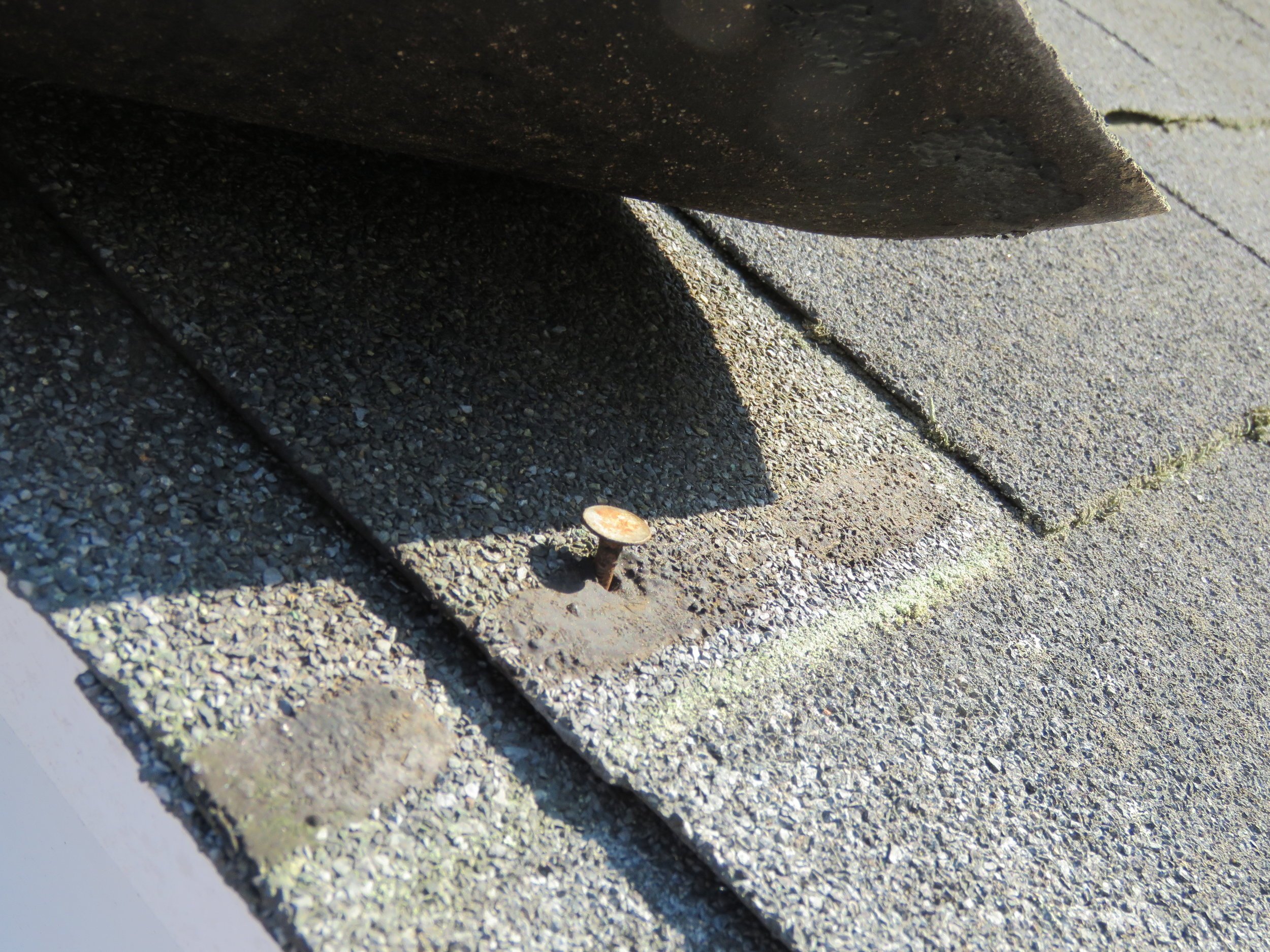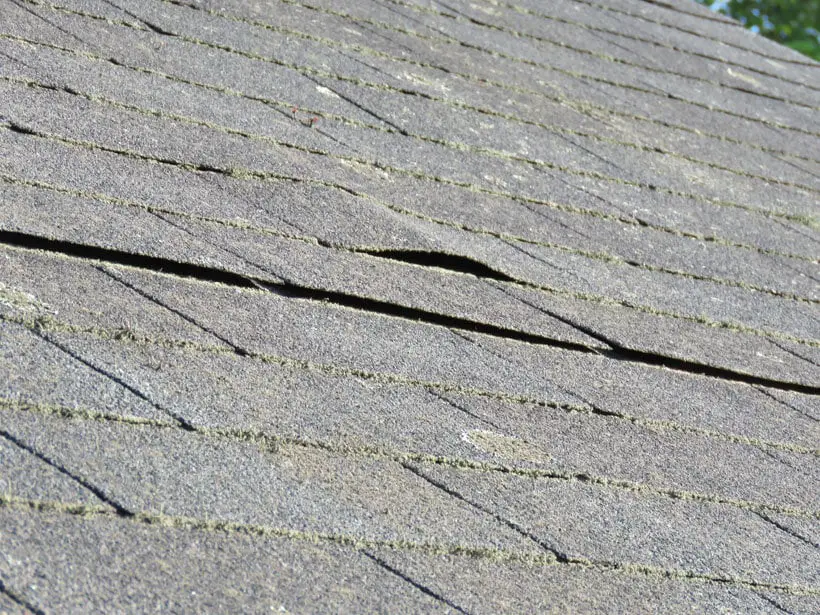Roof Nail Pops • Causes, Consequences & How to Fix Them
By Jack Gray, Roof Online Editor • Last updated April 11, 2023
Table of Contents
- What are Roof Nail Pops?
- The Building Code and Roofing Nails
- Why are Roof Nail Pops a Problem?
- What You Will Need
- How to Do It
- Related Pages

What are Roof Nail Pops?
Roof nail pops, also called “backed-out nails”, are a type of roof defect where the roofing nails which secure the shingles have been forced back and out of the roof sheathing due to cyclical changes in the pressure exerted on the nail by the surrounding wood. It can look like shingles popping up on the roof.
Wood roof sheathing (plywood, OSB, wood plank) swells due to increased humidity and high temperatures. When it cools and dries out, it contracts. Repetitions of this process reduces the ability of the wood to hold the nail.
As the nail loosens, every time the wood swells it pushes the nail out of the hole a little bit more. Eventually, this leads to visible roof nail pops, with lifted or punctured asphalt roof shingles.
Roof nail pops tend to be a common issue on roofs with poorly-ventilated attics, where extreme overheating of the roof occurs, as well as on roofs that were installed while the roof sheathing was not dry.
Wet wood typically means swollen wood. Nailing into damp wood prevents the nails from being properly held in place by the wood right from the start.
Another situation where roof nail pops are common is on roofs where a second layer of shingles has been installed over an existing roof. In this case, a common issue is the use of roofing nails that are too short to properly penetrate the sheathing.
Nails that do not fully penetrate the sheathing and extend at least 3/8 inch beyond are particularly susceptible to backing-out, partly due to the shape of the nail. If the tapered section at the end of the nail shank ends up embedded in the sheathing instead of penetrating all the way through and out the other side, you can expect problems.
The Building Code and Roofing Nails
The following is from the 2021 International Building Code section covering asphalt shingles:
“1507.2.5 Fasteners
Fasteners for asphalt shingles shall be galvanized, stainless steel, aluminum or copper roofing nails, minimum 12-gage [0.105 inch (2.67 mm)] shank with a minimum 3/8-inch-diameter (9.5 mm) head, of a length to penetrate through the roofing materials and not less than 3/4 inch (19.1 mm) into the roof sheathing. Where the roof sheathing is less than 3/4 inch (19.1 mm) thick, the nails shall penetrate through the sheathing. Fasteners shall comply with ASTM F1667.”
This language is partly intended to prevent roof nail pops.
Note that 3/4-inch is very thick for roof sheathing, and you probably won’t see sheathing this thick on any house built in the last few decades.
If your roof sheathing is less than 3/4-inch thick (and it probably is) and you don’t see the tips of the roofing nails coming through the underside of the sheathing panels, not only are you more likely to develop roof nail pops, but you might actually have a code violation on your hands, depending on when the house was built.
Why are Roof Nail Pops a Problem?
Roof nail pops are unattractive, for one thing. Your roof will have bumps and humps and out-of-place shadows. So, roof nail pops are an aesthetic issue.
The more serious issues with roof nail pops are performance-related. By forcing the shingles up, they create a pathway for wind-driven rain to reach the roof sheathing and to enter your house as a roof leak.
By forcing the shingles up, the backed-out nails break the bond between shingles created by the shingles’ self-sealing strip or any added roof cement. This will greatly increase the chance of wind damage to your roof. Wind agitation of the shingles can lead to cracked, torn, or broken shingles, and probably punctures at the location of the roof nail pops themselves.
If the bond between the shingles is particularly strong and can resist this pressure from below, the nail heads will simply puncture the shingle, giving rain a direct path into your house, through the hole in the shingle and down the nail hole underneath it.
What You Will Need
Tools
- Flat Bar See on Amazon
- Hammer See on Amazon
- Trowel See on Amazon or Caulk Gun See on Amazon
Materials
- Roof Cement, Trowel-Applied See on Amazon or Roof Cement, Caulk Gun-Applied See on Amazon
- Roofing Nails See on Amazon

How to Do It
- Lift the existing shingle right above the area where the nails are backing out.
- CAUTION: Do not over-lift the existing in-place shingles. Repairs on asphalt shingle roofs are best done when the temperature is warm enough so the shingles can soften somewhat, so you can work with the shingles without cracking or breaking them.
- Note: Replacing the nail is preferred over re-driving the nail. If the shingle covering the backed-out nail can be raised enough (without cracking it) for you to use a hammer directly on the backed-out nail, you can re-drive the nail with a hammer directly to the nail head. If the nail is bent, rusted, or too loose to stay firmly in place, remove it completely. Use a new #11 or #12 aluminum, copper, or galvanized steel barbed ring shank roofing nail with 3/8-inch to 7/8-inch diameter heads. New nails should be long enough to penetrate into wood plank decks at least 1 inch, or go completely through plywood or OSB decks. Drive the new nail into the shingle in a new location about an inch above the old location. Do not drive the new nail into the old nail hole.
- If the shingle covering the nail cannot be raised enough to expose the nail head so a hammer can be used, use a flat bar. Place the end of the flat bar on top of the nail head and tap the bar with a hammer to re-drive the nail back into the deck. You will use the flat bar in a similar manner as you would use a nailset. You should drive the nail in far enough so that the nail head is flush with the surface of the shingle. Do not damage the shingle by over-driving the nail in past the the surface of the shingle.
- After you’ve installed the new nails, or re-driven the old nails, cover the nail heads with a 1-inch wide spot application of industrial grade, asbestos-free roof cement. If you’ve replaced the nails, be sure to apply roof cement to the old nail holes as well.
- Apply similar spot applications of roofing cement to the underside of the tab of the lifted shingle which will sit on top of the shingle you were working on. Five spots, one in each corner and the other three spaced evenly across the bottom of the shingle. All spots of roof cement should be applied back about one inch from the edge of the shingle you’re applying it to, so it doesn’t ooze out and become visible when you press the shingle down.
- Lower the lifted shingle back down onto the shingle beneath it, firmly pressing the shingle tabs into the roof cement to adhere the shingle tabs.
About the Author
Jack Gray is a principal roof consultant and vice president at the Moriarty Corporation, an award-winning building enclosure consultant firm founded in 1967. He is also the editor of the Roof Online website.

Mr. Gray has worked in the roofing industry for over 25 years, with training and practical experience in roof installation, roof inspection, roof safety, roof condition assessment, construction estimating, roof design & specification, quality assurance, roof maintenance & repair, and roof asset management.
He was awarded the Registered Roof Observer (RRO) professional credential in 2009.
He also served as an infantry paratrooper in the 82nd Airborne Division and has a B.A. from Cornell University. Read full bio.
Related Pages
Asphalt Shingle Roofing: Useful Information Guide
Best Roof Cement Guide • Top 5 Roof Cement Products
Best Roof Repair Tape • Top 5 Roof Sealant Tapes
Best Roof Shingles Guide • Top 7 Shingle Brands
How Long Does a Roof Last? • Roof Lifespan for 49 Roof Types
How Much Does an Asphalt Shingle Roof Cost?
